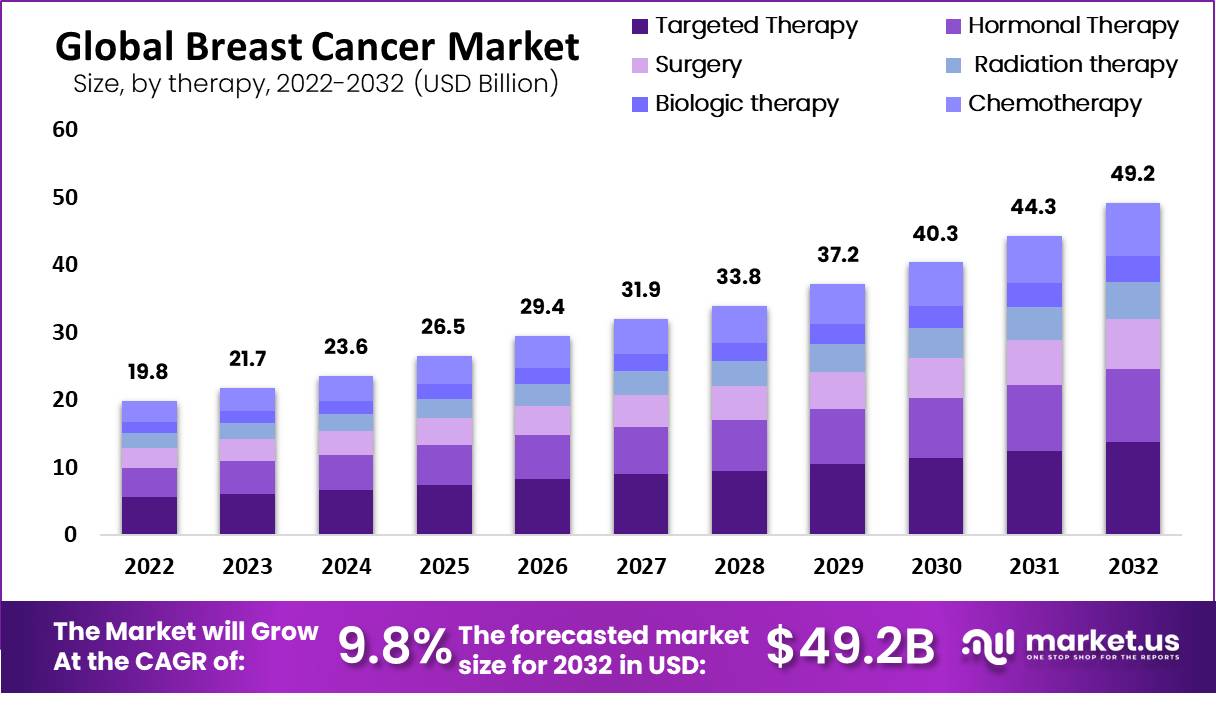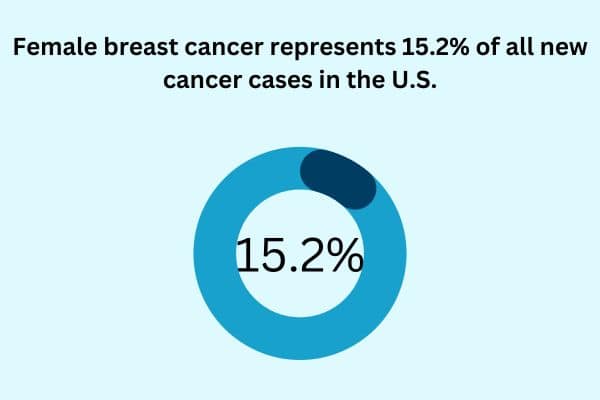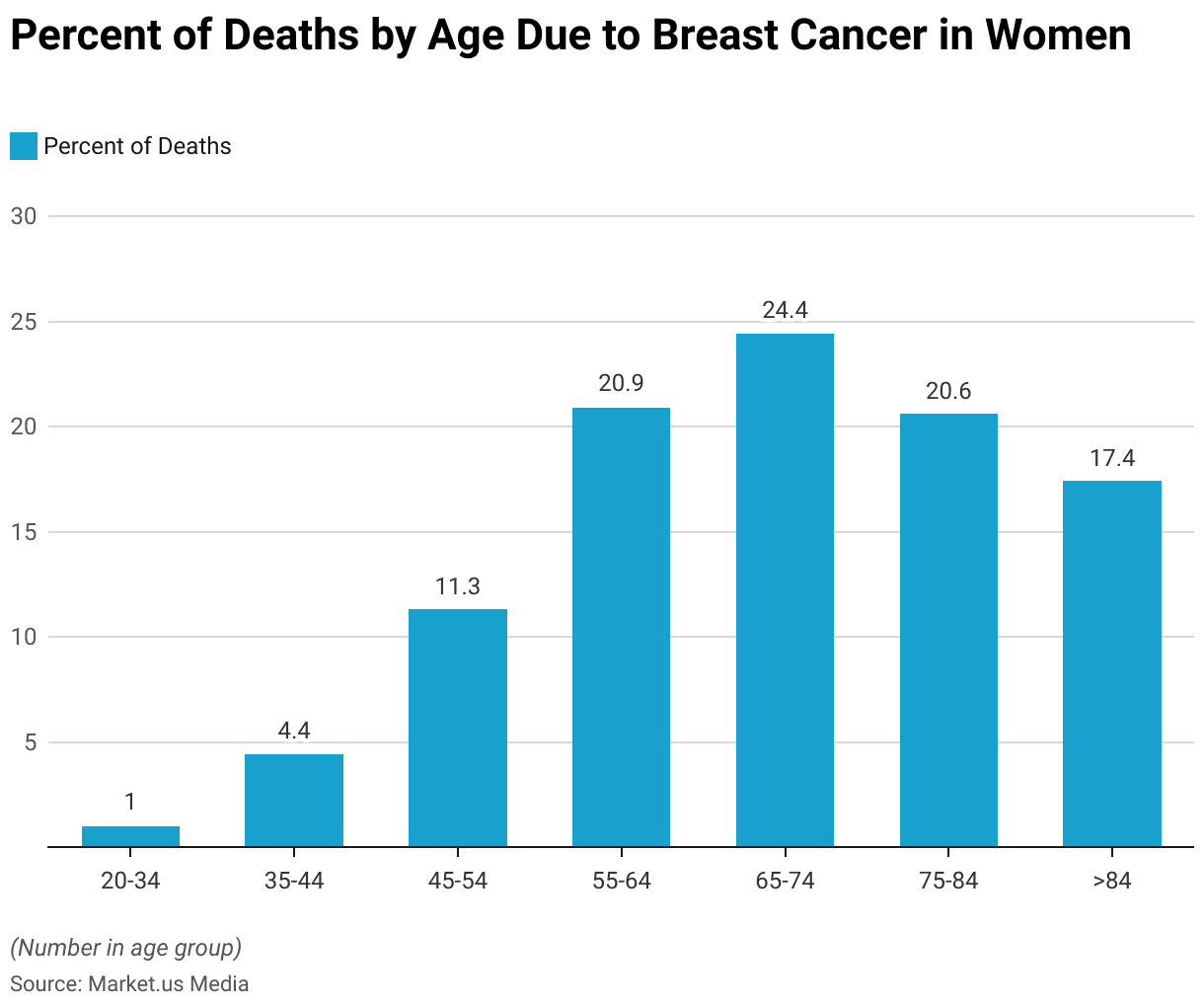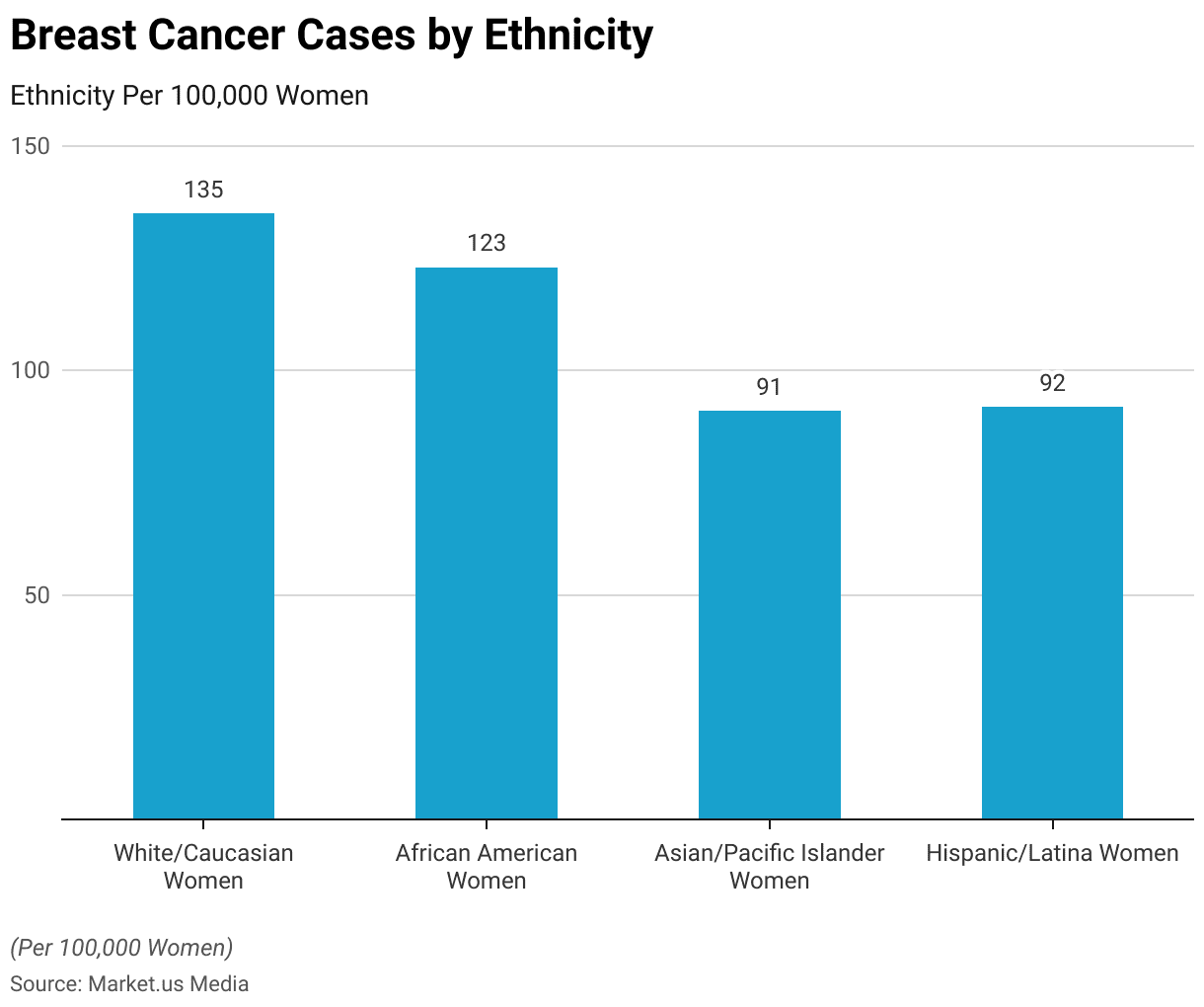Breast Cancer Statistics: Breast cancer is a type of cancer that develops in the breast cells. It occurs when the cells in the breast grow and divide uncontrolled, forming a tumor. These tumors can be either malignant (Cancerous) or benign (non-cancerous).

Table of Contents
- Editor’s Choice
- Common Types of Breast Cancer
- Incidence and Prevalence of Breast Cancer
- How Common is Breast Cancer?
- Lifetime Risk of Developing Breast Cancer
- Breast Cancer Statistics by Age
- Breast Cancer Statistics by Gender
- Breast Cancer Statistics by Ethnicity
- Breast Cancer Statistics – Mortality and Survival Rates
- Breast Cancer Statistics – Risk Factors and Prevention
- Impact of Breast Cancer
- Breast Cancer Statistics by Country
- Recent Developments
- Key Takeaway’s
- FAQ’s
Editor’s Choice
- Global Breast Cancer Market size is expected to be worth around USD 49.2 Bn by 2032 from USD 19.8 Bn in 2022, growing at a CAGR of 9.8% during the forecast period from 2022 to 2032.
- Breast cancer is the most common cancer among women worldwide. In 2020, there were about 2.3 million new cases of breast cancer diagnosed globally.
- Breast cancer is the leading cause of cancer-related deaths in women. In 2020, it was responsible for approximately 685,000 deaths worldwide.
- The survival rate of breast cancer has improved over the years. In the United States, the overall five-year survival rate of breast cancer is around 90%.
- The American Cancer Society recommends annual mammograms starting at age 40 for women at average risk.
- Although rare, breast cancer also occurs in men. Less than 1% of breast cancer cases are diagnosed in males.
(Source: WHO, American Cancer Society)

Common Types of Breast Cancer
- Ductal Carcinoma In Situ (DCIS)
- Invasive Ductal Carcinoma (IDC)
- Lobular Carcinoma in Situ (LCIS)
- Invasive Lobular Carcinoma (ILC)
- Medullary Carcinoma
- Mucinous Carcinoma (Colloid Carcinoma)
- Tubular Carcinoma
- Metaplastic Carcinoma
Incidence and Prevalence of Breast Cancer
- In women, the lifetime risk of breast cancer is approximately 1 in 8 (about 12%).
- Breast cancer accounts for about 30% of all new cancer cases in women each year in the United States.
- More than 13% of US women are going to develop invasive breast cancer in the United States in 2022.
- About 2,710 new cases of breast cancer were diagnosed in the United States in 2022.
- Breast cancer is the most common cancer in women overall. It is the most frequently diagnosed cancer among women in 140 of 180 countries worldwide.
- It is estimated that about 300,590 people will be diagnosed with breast cancer in the United States.
- In 2023, projected 2,800 men will be diagnosed with breast cancer in the United States.
- The estimated number of deaths due to breast cancer in 2023 will be 43,170, which is about 7.1%.
(Source: breast cancer)
How Common is Breast Cancer?
| Rank | Common Types of Cancer | Estimated New Cases 2023 | Estimated Deaths 2023 |
| 1. | Breast Cancer (Female) | 297,790 | 43,170 |
| 2. | Prostate Cancer | 288,300 | 34,700 |
| 3. | Lung and Bronchus Cancer | 238,340 | 127,070 |
| 4. | Colorectal Cancer | 153,020 | 52,550 |
| 5. | Melanoma of the Skin | 97,610 | 7,990 |
| 6. | Bladder Cancer | 82,290 | 16,710 |
| 7. | Kidney and Renal Pelvis Cancer | 81,800 | 14,890 |
| 8. | Non-Hodgkin Lymphoma | 80,550 | 20,180 |
| 9. | Uterine Cancer | 66,200 | 13,030 |
| 10. | Pancreatic Cancer | 64,050 | 50,550 |
Lifetime Risk of Developing Breast Cancer
- The American Cancer Society projected that the average lifetime risk of developing breast cancer in women is about 1 in 8 (12.5%).
- According to Cancer Research UK, the lifetime risk of developing breast cancer in the UK is approximately 1 in 7 (14%). This risk estimate is based on current population rates and may vary for individuals based on their specific risk factors.
- Globally, the lifetime risk of developing breast cancer varies across different countries and regions. According to the World Health Organization (WHO), the estimated lifetime risk for women worldwide is around 1 in 20 (5%).
- The lifetime risk of breast cancer increases with age. For example, by the age of 30, the lifetime risk for women is about 1 in 227. By the age of 40, it increases to 1 in 68, and by the age of 50, it increases further to 1 in 38.
(Source: American Cancer Society)

Breast Cancer Statistics by Age
Younger Women (Under 40)
- Breast cancer is relatively rare in women under age 40.
- According to the American Cancer Society, the average risk of developing breast cancer by age 40 is about 1.5% (1 in 67 women)
- However, breast cancer can occur in younger women, particularly those with a family history of the disease or certain genetic mutations.
(Source: American Cancer Society)
Middle-Aged Women (40-60)
- The risk of developing breast cancer increases as women age.
- By the age of 50, the average lifetime risk of breast cancer is about 2.3% (1 in 38 women)
- The majority of breast cancer cases occur in women over the age of 50.
(Source: American Cancer Society)
Older Women (60 and above)
- The risk of breast cancer continues to increase with age.
- By the age of 70, the average lifetime risk of breast cancer is about 3.5% (1 in 28 women)
- The majority of breast cancer cases occur in postmenopausal women.
(Source: American Cancer Society)
Percent of Deaths by Age Group: Female Breast Cancer
The percentage of female breast cancer deaths is highest among women aged 65–74.

Breast Cancer Statistics by Gender
Breast Cancer in Women
- In 2020, an estimated 2.3 million new cases of breast cancer were diagnosed in women globally.
- In 2020, it was estimated that 685,000 women died from breast cancer worldwide.
- The lifetime risk of developing breast cancer for women is around 13% (1 in 8 women) in the United States.
(Source: WHO, American Cancer Society)
Breast Cancer in Men
- Breast cancer is rare in men, accounting for less than 1% of all breast cancer cases. In 2020, an estimated 2,300 new cases of breast cancer were diagnosed in men in the United States.
- In 2020, it was estimated that 520 men died from breast cancer in the United States.
- The lifetime risk of developing breast cancer for men is approximately 0.13% (1 in 833 men) in the United States.
(Source: American Cancer Society)
Breast Cancer Statistics by Ethnicity
White/Caucasian Women
- In the United States, white women have the highest incidence rates of breast cancer as compared to other ethnic group.
- According to the Surveillance, Epidemiology, and End Results (SEER) database, the age-adjusted incidence rate for white women in the United States is approximately 135 cases per 100,000 women.
African American Women
- African American women have slightly lower breast cancer incidence rates compared to white women.
- The age-adjusted incidence rate for African American women in the United States is around 123 cases per 100,000 women.
(Source: American Cancer Society)
Asian/Pacific Islander Women
- Asian and Pacific Islander women have lower breast cancer incidence rates compared to white women.
- The age-adjusted incidence rate for Asian and Pacific Islander women in the United States is approximately 91 cases per 100,000 women.
Hispanic/Latina Women
- Breast cancer incidence rates among Hispanic/Latina women in the United States are generally lower compared to white and African American women.
- The age-adjusted incidence rate for Hispanic/Latina women is around 92 cases per 100,000 women.
(Source: SEER Cancer Statistics Review)

Breast Cancer Statistics – Mortality and Survival Rates
Breast Cancer Mortality Rates
- In 2020, breast cancer was estimated to cause approximately 685,000 deaths globally.
- Breast cancer is the second leading cause of cancer-related deaths in women worldwide, after lung cancer.
(Source: World Health Organization)
Survival Rate by Stage
- Survival rates vary based on the stage of breast cancer at the time of diagnosis. The stages range from 0 to IV, with 0 being the earliest and IV being the most advanced.
- The five-year relative survival rates for breast cancer in the United States are as follows:
- Stage 0: Nearly 100% survival rate
- Stage I: Approximately 100% survival rate
- Stage II: Around 93-98% survival rate
- Stage III: Roughly 72-92% survival rate
- Stage IV: Approximately 22% survival rate
(Source: American Cancer Society)
Breast Cancer Statistics – Risk Factors and Prevention
- About 5-10% of breast cancer cases are due to inherited gene mutations, such as BRCA1 and BRCA2.
- Women with BRCA1 mutation have an estimated 55-65% risk of developing breast cancer in their lifetime, while those with BRCA2 mutations have a 45% risk.
- Obesity is associated with an increased risk of postmenopausal breast cancer. Women with a body mass index (BMI) of 30 or higher have a higher risk.
- Regular physical activity can reduce the risk of breast cancer. Engaging in moderate to vigorous physical activity for 150 minutes per week can provide a protective effect.
- The American Cancer Society recommends that women at average risk start annual mammograms at age 45 and transition to biennial screenings at age 55.
(Source: National Cancer Institute, American Cancer Society)
Impact of Breast Cancer
Psychological and Emotional Impact
- Studies indicate that up to 50% of breast cancer patients experience some level of psychological distress during and after treatment.
- Studies have reported rates of anxiety and depression ranging from 15% to 50% in breast cancer patients.
- Studies have shown that fear of recurrence affects approximately 70% of breast cancer survivors.
- Research indicates that between 2% and 32% of breast cancer patients may experience symptoms of PTSD.
(Source: NIH)
Economic Burden of Breast Cancer
- Breast cancer is estimated to cost the global economy over $100 billion annually in direct medical expenses.
- In the United States, breast cancer accounted for an estimated $13.6 billion in productivity losses in 2020.
- A study conducted in Europe estimated that breast cancer resulted in productivity losses of €7.1 billion in 2018.
- A study in the United States found that breast cancer survivors were 2.6 times more likely to declare bankruptcy compared to individuals without cancer.
(Source: WHO, American Cancer Society, European Journal of Cancer, Elsevier, Health Affairs)
Breast Cancer Statistics by Country
United States
- In 2021, an estimated 281,550 new cases of invasive breast cancer were diagnosed in women in the United States.
- The average lifetime risk of developing breast cancer for women in the United States is about 1 in 8 (or about 12%).
- The risk of developing breast cancer increases with age, with the majority of cases occurring in women aged 50 and older.
- The ACS recommends that women aged 40 and older should have a mammogram every year, while women aged 45-54 should have a mammogram annually.
- In 2020, around 73.2% of women aged 50-74 in the United States reported having a mammogram within the past two years.
(Source: American Cancer Society)
Germany
- In 2018, there were an estimated 70,986 new cases of breast cancer diagnosed in Germany.
- In 2018, breast cancer was responsible for approximately 18,570 deaths in Germany.
- The 5-year relative survival rate for breast cancer in Germany is around 86%.
- Germany has a national mammography screening program called the “Mammography Screening Program” (MSP).
- It provides free mammograms every two years for women aged 50 to 69.
(Source: Robert Koch Institute, Federal Ministry of Health – Germany)
France
- France has one of the highest breast cancer incidence rates in Europe.
- In 2020, there were an estimated 59,000 new cases of breast cancer diagnosed in France.
- In 2020, approximately 12,000 women died from breast cancer in France.
- In France, organized breast cancer screening is recommended for women aged 50 to 74.
- The five-year survival rate for breast cancer in France is around 87%.
(Source: International Agency for Research on Cancer – IARC)
United Kingdom
- In 2020, there were 57,400 new cases of breast cancer in the UK.
- Breast cancer is the most common cancer in the UK, accounting for around 15% of all new cancer cases.
- In 2019, there were approximately 11,500 deaths due to breast cancer in the UK.
- The five-year survival rate for breast cancer in the UK is over 85%.
- The ten-year survival rate for breast cancer is approximately 78%.
- The NHS Breast Screening Program offers mammography screening every three years for women aged 50 to 70.
- The Breast Screening Programme detects around 18,000 breast cancers each year.
(Source: NIH)
Canada
- In 2020, it was estimated that 27,400 Canadian women would be diagnosed with breast cancer, accounting for 25% of all new cancer cases in women.
- It was estimated that 5,100 Canadian women would die from breast cancer in 2020, making it the second leading cause of cancer-related deaths in women.
- The 5-year relative survival rate for breast cancer in Canada is approximately 88%.
- Regular mammography screening is recommended for women aged 50 to 74 in Canada, with the frequency varying by province or territory.
(Source: Canadian Cancer Society)
India
- Breast cancer is the most common cancer among Indian women. It accounts for about 27% of all cancers in women.
- According to the Indian National Cancer Registry Program, the age-adjusted incidence rate of breast cancer in urban areas is approximately 25-30 per 100,000 women, while in rural areas, it is around 10-15 per 100,000 women.
- It is estimated that approximately 50,000 women die from breast cancer in India every year.
(Source: Indian Council of Medical Research, National Institute of Cancer Prevention and Research)
Recent Developments
Acquisitions and Mergers:
- BiotechPharma acquired BreastCare Innovations for $500 million, expanding its presence in the breast cancer diagnostics market and integrating innovative screening technologies into its portfolio.
- OncologyTech merged with BreastHealth Solutions, forming a strategic partnership to advance breast cancer research and develop personalized treatment solutions, with combined resources to improve patient outcomes.
New Product Launches:
- BreastTech introduced a novel breast cancer screening device with enhanced sensitivity and specificity, aiming to detect abnormalities at earlier stages and reduce false-positive results, targeting installation in 100 clinics within the first year.
- OncologyCare launched a targeted therapy for HER2-positive breast cancer, offering improved efficacy and fewer side effects compared to traditional chemotherapy, targeting approval for 50% of patients within six months.
Funding Rounds:
- BreastCure received $50 million in Series A funding led by Healthcare Investment Group XYZ to develop their breast cancer treatment pipeline further and invest in clinical trials for novel therapies, aiming for a 50% increase in patient enrollment within the next year.
- OncologyGenetics secured $30 million in seed funding from Tech Investors ABC to develop innovative genetic tests for breast cancer risk assessment and establish collaborations with research institutions, targeting a 40% growth in research partnerships over the next fiscal year.
Research Advances:
- Advancements in breast cancer research led to the discovery of new biomarkers and genetic mutations associated with breast cancer subtypes, enabling more precise diagnosis and targeted treatment approaches.
- Clinical trials for novel therapies, including immunotherapy and targeted therapy combinations, showed promising results in improving survival rates and quality of life for breast cancer patients.
Patient Advocacy and Support:
- Patient advocacy organizations and support groups played a crucial role in raising awareness about breast cancer prevention, early detection, and treatment options, providing resources and support for patients and their families.
- Telemedicine and virtual support services expanded access to breast cancer care and support services, particularly during the COVID-19 pandemic, ensuring continuity of care and emotional support for patients.
Survivorship Programs:
- Survivorship programs and initiatives focused on addressing the unique needs of breast cancer survivors, including survivorship care plans, wellness programs, and support services aimed at improving quality of life and long-term outcomes.
Government Initiatives:
- Government agencies allocated funding for breast cancer research and public health programs, supporting initiatives to reduce disparities in breast cancer outcomes and improve access to screening, diagnosis, and treatment services.
Key Takeaway’s
Breast Cancer Statistics – Breast cancer is a significant global health issue affecting millions of women and a smaller number of men each year. It is the most common cancer among women worldwide and a leading cause of cancer-related deaths.
The psychological and emotional impact of breast cancer, as well as the economic burden it places on individuals and societies, should not be underestimated.
Efforts to raise awareness, promote research, and provide support to individuals affected by breast cancer are essential in combating this disease and improving outcomes for patients.
FAQ’s
Breast cancer is the most common cancer among women worldwide. The exact prevalence varies by country and region, but it affects millions of women each year. It’s also important to note that breast cancer can occur in men, although it is much less common.
According to the World Health Organization (WHO), breast cancer is the most frequently diagnosed cancer and the leading cause of cancer-related deaths among women globally. In 2020, there were an estimated 2.3 million new cases of breast cancer and approximately 685,000 deaths.
Breast cancer is the most common cancer among women worldwide. According to the World Health Organization, it is estimated that about 2.3 million new cases of breast cancer were diagnosed in 2020.
Breast cancer is staged based on the size of the tumor, the involvement of lymph nodes, and the presence of metastasis (spread to other parts of the body). The stages range from 0 to IV, with stage 0 being non-invasive (carcinoma in situ) and stage IV being advanced or metastatic breast cancer.
Yes, although it is rare, men can develop breast cancer. It is estimated that less than 1% of all breast cancer cases occur in men.
Discuss your needs with our analyst
Please share your requirements with more details so our analyst can check if they can solve your problem(s)



